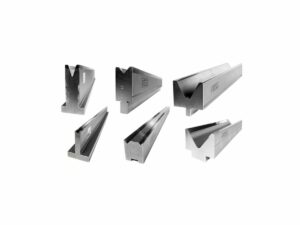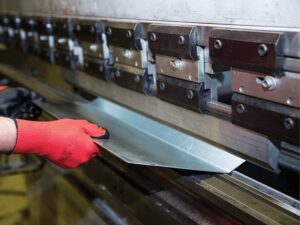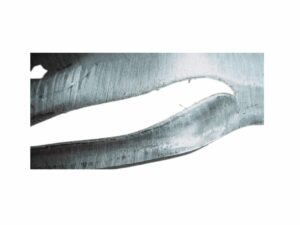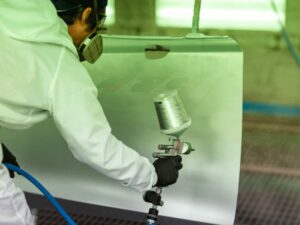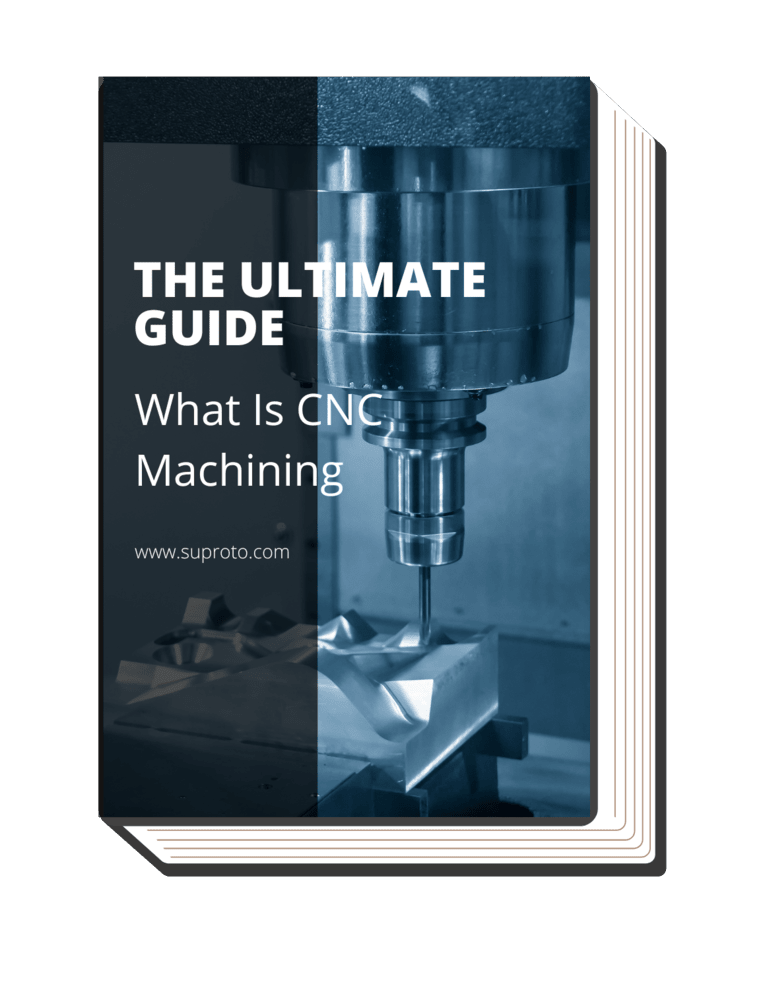1. Step#1 Design and Preparation
Blueprint to Success
The initial design phase is the foundation of the sheet metal bending project. For me, creating a thorough blueprint can avoid pitfalls and ensure that the fabrication process is streamlined and efficient. Paying close attention to the details of the design, such as bend deductions, flange lengths, and material properties, is crucial to the success of the bending process.
Highlights:
- Considering Uniform Wall Thickness
I have seen how imperative it is to maintain a uniform wall thickness throughout the design to ensure that the bends are consistent and free of deformities. This consistency helps in avoiding unexpected material behavior during the bending process and ensures a higher-quality finished product
When designing for sheet metal bending, it’s important to adhere to design rules regarding the spacing between holes, slots and bends. This is essential in preventing deformation and ensuring that the structural integrity of the component is not compromised during the bending process
When bending sheet metal, selecting an appropriate bending die is crucial. One common issue is the selection of a V-groove width that is too large, which may cause the material to slip during processing. It’s advised that a V-groove width of 4 to 6 times the material thickness is chosen.
In situations where the internal bending width is narrower than that of the standard mold, there is a cause for concern. The standard width of the lower die of the bending machine must be at least 10mm. Solutions to avoid displacement of the mold include increasing the size of the bend by negotiating with the customer, special processing of the mold, or using grinding tools although it may increase processing costs
2. Step#2 Material Selection
Choosing The Armor
Material selection is akin to choosing the armor that will best protect and serve the project. Each material has unique properties, such as yield strength and elasticity, which dictate how it will behave during the bending process. Trust me, knowing and understanding these properties is critical in choosing a material that will meet the specifications and requirements of the design
Highlights:
- Picking the Right Material
Different materials have varying yield strengths which affect how much force is required for bending. Selecting the appropriate material is essential to ensure that the finished product meets the desired specifications and performance criteria
Speaking from an encounter, the thickness of the material is a key factor in sheet metal bending. It’s vital to understand how material thickness impacts the bending process, including the bend radius and the amount of force required. Selecting the appropriate thickness based on design requirements ensures the structural integrity and functionality of the finished product.
Different materials have varying microstructures which can affect the bendability. Factors like residual stress, and the shape, size, and orientation of grains in the sheet influence how the material will bend. Intermetallic particles or precipitates can adversely affect bendability.
During the bending process, some materials, especially brittle ones, may develop cracks. This is due to different responses to stress induced during bending. Attention to the material’s microstructural features and an understanding of how they influence crack formation can help in selecting the right materials for the bending process.
3. Step#3 Marking and Measurement
Precision Marksmanship
Precision in marking and measurement is paramount in the sheet metal bending process to ensure the final product is of the highest quality. The bending radius must be accurately measured, as it directly correlates with the strength of the material. Believe me, an incorrect bending radius, for example, can cause deformation, reduced strength, and damage to the material.
Highlights:
Ensuring that the bend radii are at least equal to the thickness of the sheet metal is critical and helps in maintaining uniformity, thus reducing costs. Keeping the bend radii consistent is also vital for the structural integrity and performance of the finished product.
- Calculating Bend Allowance
I have learned from experience that Bend allowance refers to the arc length of the bend measured along the neutral axis of the material. A precise calculation of bend allowance is critical to ensure the accuracy of the final product’s dimensions and to account for material stretching.
- Hole Proximity to Bending Line
If a hole is too close to the bending line, bending can cause the hole to pull and distort the material. This is due to tensile forces during the bending process. Solutions include increasing the size of the bend and trimming the hem after forming.
Precise marking and measurement are vital for achieving desired outcomes in sheet metal bending. Inaccurate markings can lead to misalignments or faulty bends. Advanced measuring tools and machines should be employed to ensure high precision.
The table below highlights the importance and benefits of accuracy in markings for sheet metal bending. Explore how precise markings contribute to proper alignment, consistent quality, time and cost savings, enhanced precision, versatility, and improved safety and compliance. Discover the advantages of employing advanced measuring tools and machines for achieving high precision in sheet metal bending processes.
| Accuracy in Markings Benefits |
Description |
| Precise Alignment and Fit |
Accurate markings ensure precise alignment of the sheet metal, facilitating proper bending and forming. This precision results in clean and accurate bends that fit together seamlessly, reducing the need for rework or adjustments. Achieving the desired dimensions and angles in the final product becomes easier when accurate markings guide the bending process. |
| Consistency and Quality |
Accurate markings contribute to consistent and high-quality results in sheet metal bending. By ensuring precise measurements and markings, manufacturers can maintain consistency across multiple bends or parts, leading to uniformity in the final products. Consistency and quality are vital in industries where tight tolerances and strict specifications are required, such as aerospace or automotive manufacturing. |
| Time and Cost Savings |
Accurate markings help streamline the sheet metal bending process, resulting in time and cost savings. Properly marked sheets eliminate the need for guesswork or trial and error, reducing the chances of errors, rework, or material wastage. This efficiency translates into shorter production cycles, improved productivity, and reduced overall manufacturing costs. |
| Enhanced Precision and Versatility |
Precision in markings enables sheet metal fabricators to achieve intricate and complex bends accurately. Accurate measurements allow for precise adjustments, resulting in the creation of intricate shapes or custom designs. The ability to achieve precise and consistent bends expands the versatility of sheet metal bending, making it suitable for various applications and industries. |
| Improved Safety and Compliance |
Accurate markings promote safety and compliance in sheet metal bending. Properly marked sheets reduce the risk of errors or miscalculations that could lead to structural integrity issues or safety hazards. Adhering to precise markings ensures compliance with industry standards, customer requirements, and design specifications, ultimately enhancing product safety and reliability. |
4. Step#4 Setup and Adjustment
Setting the Stage
The setup and adjustment phase is where the stage is set for the bending process. This stage involves configuring the machines and tools, such as the Brake Press, according to material specifications. I can tell that it also requires a thorough understanding of different bending methods.
Highlights:
Different bending methods are available for sheet metal bending, including V-bending and the use of various dies like radius dies and U-bend dies, depending on the material and desired shape. Suproto ventures to choose the appropriate bending method are essential to achieve the desired precision and quality of the finished product
The Brake Press is an essential tool in traditional fabrication shops for sheet metal bending. It presses the sheet metal between the upper die and the lower die. I believe proper configuration based on material specifications is vital to ensure that the bending process is efficient and results in a product that meets design requirements.
For safety and to avoid scrap, it is imperative that the mold is securely fixed on the mold base. A securely attached mold prevents displacement and subsequent safety accidents during the bending process.
Springback is a common phenomenon where the material tries to return to its original shape after bending. Managing springback is essential for achieving the desired angle and dimensions. Techniques such as using simulation, adjusting process parameters, and employing specific die designs can help manage springback.
5. Step#5 Bending
Art of Transformation
Bending is the cornerstone of sheet metal fabrication, transforming flat sheets into complex shapes. This involves applying force to the metal, causing plastic deformation, without fracturing. The artful execution of bending processes necessitates an understanding of material properties, bend radius, and bend allowance.
Highlights:
When executing the bend, it is essential to apply the correct amount of force to achieve plastic deformation without causing damage to the material. Suproto, a renowned manufacturer in the metal fabrication industry, stresses the importance of understanding the material’s properties and using the appropriate bending methods for the desired result
According to Science Direct, spring back is the most important phenomenon that affects the accuracy of sheet metal parts. To account for springback, technicians must anticipate the degree of springback and adjust the bend angle accordingly to achieve the desired final shape.
- Consistent Bending Angles
Ensuring that all bends are consistent in terms of angles and dimensions is challenging, especially in high-volume production. Implementing real-time monitoring systems and using CNC (computer numerical control) machines can help maintain consistency.
- Avoiding Material Deformation
During bending, materials may undergo unintended deformations such as warping or twisting. This is especially true for materials with heterogeneous properties. For me, proper process adjustments and material pre-treatments may be necessary to mitigate these issues.
6. Step#6 Inspection and Quality Control
Eagle Eyes on Quality
The final phase in the sheet metal bending process is inspection and quality control, which is vital to ensure that the bent parts meet the design specifications and are free from defects. This stage involves meticulous checking for deformities, and ensuring dimensional accuracy. For example, non-destructive testing methods might be employed to check the integrity of the parts.
Highlights:
After the bending process, the parts must be inspected for any deformities such as cracks or undesired distortions that might have occurred during bending. At Suproto, any such issues must be addressed before the parts move to the next phase or are shipped.
- Ensuring Dimensional Accuracy
Take this into heart, ensuring that the dimensions of the bent part are in alignment with the design specifications is critical. This includes checking the angles, lengths, and overall shape of the part to ensure that it is within acceptable tolerance levels.
- Detecting Microscopic Defects
Certain defects like micro-cracks or internal stresses are not visible to the naked eye. Implementing advanced non-destructive testing methods is essential for detecting such microscopic defects.
- Geometrical Specifications
A critical aspect is ensuring that the bent parts conform to the Geometrical Product Specifications set out in the design. This involves ensuring that the macro-geometry (size, form, orientation, location) and micro-geometry (surface texture) of the parts comply with standards and design specifications.
7. Step#7 Post-Bending Operations
Finishing with a Flourish
After the bending process is complete, post-bending operations are essential to ensure that the part is ready for assembly or final use. I recognized this stage encompasses cleaning, finishing, and the addition of features to the bent parts. Implementing the post-bending operations correctly is essential in achieving not just functionality but also the aesthetic quality of the part.
Highlights:
Cleaning and finishing include removing any debris, or oils, and ensuring the surface is free from any contamination. In my experience, it’s important to follow a set of guidelines for sheet metal fabrication, which include essential post-bending operations that improve part manufacturability, enhance cosmetic appearance, and reduce overall production time.
- Countersinks and Adding Features
Countersinks and other features are added to the bent parts using various hand tools or machines. These additions can include holes, notches, or etchings that facilitate assembly or serve a specific function in the finished product. It’s essential to ensure precision in this process to maintain the structural integrity and functionality of the part.
- Residual Stress Management
After bending, the sheet metal may contain residual stresses which can affect its structural integrity. Post-bending operations such as stress-relieving heat treatments are often necessary to mitigate these stresses. Mechanical processing, stress-relieving heat treatment, process management during the heat-treating process, and alloy choice can all help with this.
- Surface Finish Restoration
The bending process might affect the surface finish of the material. Post-bending operations including polishing, coating, or other surface treatments are often required to restore the desired surface finish and appearance.
Dive Deeper Into Our Resources
Looking for more diverse product options? Browse through our handpicked selections:
For some insightful reads, we’ve curated a list of recommended articles just for you:
Still haven’t found what you’re looking for? Don’t hesitate to contact us. We’re available to assist and guide you.
Conclusion
Through this guide, we have seen various aspects of the process highlighted. The versatility of sheet metal bending was emphasized, showing its significance in manufacturing complex geometries without the need for tooling, resulting in streamlined assembly processes and cost reductions.
One question that arises is: Do your businesses consider how incorporating advanced sheet metal bending techniques can impact product quality and production efficiency? For any queries or detailed information on how to optimize sheet metal bending processes, please don’t hesitate to reach out. Our team is on standby, eager to provide the insights and solutions needed to elevate the business to new heights. Contact us today!

